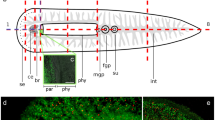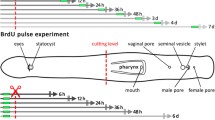Summary
-
1.
Regeneration studies were made onAmphiscolops langerhansi,A. bermudensis, andConvoluta sutcliffei.
-
2.
The statocyst never regenerates but can be maintained, following transplantation to a statocystless worm, at any site in the peripheral parenchyma.
-
3.
Eyespots regenerate readily. Extra eyespots are not uncommon.
-
4.
Regeneration of whole animals from the inner parenchyma or the epidermis, alone, was never observed.
-
5.
Regeneration of whole animals from pure preparations of peripheral parenchyma is probable.
-
6.
Grafts of material wholly or in large part derived from peripheral parenchyma are able to determine the appearance of new structures in the host which reflect the origin of the donor material.
-
7.
Comparisons between acoel and triclad regeneration are discussed.
Similar content being viewed by others
Reference
Ax, P.: Relationships and phylogeny of the Turbellaria. In: The lower Metazoa (eds. E. S.Dougherty, Z. N.Brown, E. D.Hanson and W. D.Hartman), p. 191–224. pp. 468. Univ. Calif. Press 1963
Dorey, A. E.: The organization and replacement of the epidermis in acoelous turbellarians. Quart. J. micr. Sci.106, 147–172 (1965).
Hanson, E. D.: Asexual reproduction in acoelous Turbellaria. Yale J. Biol. Med.33, 107–111 (1960).
—:Convoluta sutcliffei, a new species of acoelous Turbellaria. Trans. Amer. micr. Soc.80, 423–433 (1961).
Hyman, L. H.: Reproductive system and copulation inAmphiscolops langerhansi (Turbellaria Acoela). Biol. Bull.72, 319–326 (1937).
—: Acoel and polyclad Turbellaria from Bermuda and the Sargassum. Bull. Bingham Oceanographic Coll.7, 1–26 (1939).
—: The Invertebrates. Platyhelminthes and Rhynchocoela. New York: McGraw-Hill Book Co. 1951.
Keil, E.: Regeneration inPolychaeruscaudatus Mark. Biol. Bull.57, 223–244 (1929).
Lender, T.: Mise en évidence et propriétés de l'organisin de la régénération des yeux de la planairePolycelis nigra. Rev. Suisse Zool.62, 268–275 (1955).
Pedersen, K. J.: The cellular organization ofConvoluta convoluta, an acoel turbellarian: a cytological, histochemical and fine structural study. Z. Zellforsch.64, 655–687 (1964).
Steinböck, O.: Regeneration azöler Turbellarien. Verb. Dtsch. Zool. Gesell., Tübingen, S. 86–94 (1954).
—: Regenerations- und Konplantationsversuche anAmphiscolops spec. (Turbellaria Acoela). Wilhelm Roux' Arch. Entwickl.-Mech. Org.154, 308–353 (1963).
Westblad, E.: Studien über Skandinavische Turbellaria. Acoela V. Ark. Zool.41A, 1–82 (1948).
Wolff, E.: Recent researches on the regeneration of planaria. In: Regeneration (ed. D.Rudnick), p. 53–84. pp. 272 Ronald Press. Co. 1962.
Author information
Authors and Affiliations
Additional information
Contribution No. 406 from the Bermuda Biological Station.
This work was supported by a grant from the National Science Foundation.
Rights and permissions
About this article
Cite this article
Hanson, E.D. Regeneration in acoelous flatworms: The role of the peripheral parenchyma. W. Roux' Archiv f. Entwicklungsmechanik 159, 298–313 (1967). https://doi.org/10.1007/BF00573798
Received:
Issue Date:
DOI: https://doi.org/10.1007/BF00573798




